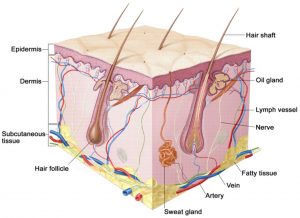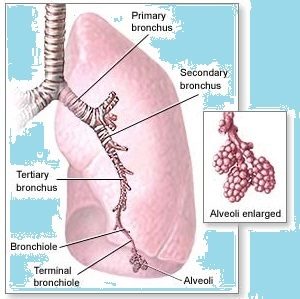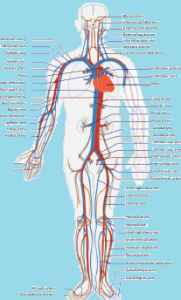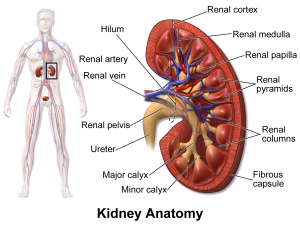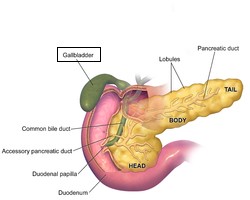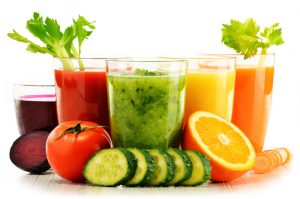
Detox Continued
Today, with more toxins in the environment than ever, “it’s critical to detox,” says Linda Page, N.D., Ph.D., the author of Detoxification. Page recommends detoxing for symptoms such as:
- Unexplained fatigue
- Sluggish elimination
- Irritated skin
- Allergies
- Low-grade infections
- Puffy eye or bags under the eyes
- Bloating
- Menstrual problems
- Mental confusion
Know it’s time for detoxing when your body show any of the above symptoms.
Once you’ve completed your fasting by consuming only water, you may start your detoxification process by paying attention to these specific organs as they are the systems of the body responsible for excreting toxins:
Use dry brushing (brush toward the heart, starting at the feet and hands and brushing toward the chest) as a technique to exfoliate the skin, clean pores and lend support to the lymphatic system. This system is a major part of the body’s immune system and some of its nodes, ducts and vessels run just below the skin surface, which is stimulated by brushing the skin and thereby help in the detoxification process. Dry brushing also has the effect of increase blood flow and thereby increase energy levels, which would be advisable to do in the morning.
- Through sweat, toxins are released through the skin and therefore exercise and making use of a sauna, greatly help transporting toxins out of the body through the skin.
- Hydrotherapy is also believed to be a great way to excrete toxins. Run hot water over the body for about 30seconds and alternate with cold water. Do this for approximately 5minutes.
Oxygen help cleans the lungs and it goes without saying that it is the one component we cannot do without. Try this exercise by by Dr. Edward Group DC, NP, DACBN, DCBCN, DABFM “…begin by breathing in deeply through your nose from your belly up. Count to five, inhaling the entire time. Even when you think you can’t inhale any more, try to squeeze a little more air in. Allow your lungs and stomach to fully inflate. This enables oxygen to reach the deepest depths of your lungs to inflate all the alveoli and break up any toxins and pollutants that may have accumulated. Hold your breath for several seconds and then exhale over the course of another five count. When you think you can’t exhale any more, keep blowing from the deepest depths of your lungs and stomach! You should feel your chest and abdomen flatten inward. Repeat this breathing exercise 9 times. Performing this exercise on a daily basis will not only help cleanse your lungs, but it also helps relieve stress. It won’t take long before you notice positive improvements!”
Exercise remain the most effective form of detox and there are various exercise methods that focus more on the process of detoxing such as Yoga, Qigong (martial-arts based exercise that includes exercises specifically for detoxifying or cleansing) etc. Exercise in general will improve your lung capacity (more oxygen), cause sweating (rid toxins through the skin), increase blood-flow (carrying oxygen and nutrients more speedily to the organs that rid toxins), ensure healthy functioning organs (excrete toxins more effective) and a general sense of wellbeing.
Functionality of,and advised Food Intake for the Detoxifying Organs mentioned below:
There are various Detox-specific diets that you can follow, however consuming the correct foods, more as a lifestyle, will ensure it’s all systems go, all the time! Also keep in mind that fresh is always better as heat/freezing in most instances destroy certain nutritious elements in food.
Some foods are more efficient at flushing toxins from certain organs, but the best overall cleanser remains good old H2O.
Internal organs that rid the body of toxins are the Blood, Colon, Kidneys, Lymphatic system, Liver, Pancreas & Gallbladder and there are certain foods that aid the process of these organs to help them function optimally.
Our blood not only carries all important oxygen to all living cells of the body but the nutrients that are imperative for their survival. White blood cells defend against infection through their antibodies. Blood transport, regulate and protect the body.
- Blood-specific food: Beans, Moringa, Cayenne Pepper, Garlic, Oregano, Coconut Water, Wheat Grass, Leafy Greens, Red Grapes and Kale
- Colon Functionality:
Being part of the digestive system, the colon’s function is threefold: to absorb remaining water and electrolytes from indigestible food matter, to accept and stores food remains that were not digested in the small intestine and to eliminate solid waste (faeces) from the body. The colon works to maintain the  body’s fluid balance.
body’s fluid balance.
- Colon-specific food: Water, Kale, Garlic, Flax Seed, Aloe Vera Juice, Green Tea, Brussel Sprouts, Lemon, Spinach, Avocado, Kefir, Apple cider vinegar, Broccoli and Chia seeds
Responsible to filter waste materials from the blood and expel them from the body as urine. The kidneys also help control the levels of water and various essential minerals in the body. In addition, they’re critical to the production of Vitamin D, red blood cells & hormones that regulate blood pressure
- Kidney-specific food: Red Bell Peppers, Ginger, Onions, Pumpkin seeds, Olive Oil, Cranberries, Turmeric, Cabbage, Cauliflower, Parsley and Tomatoes
The primary function of the lymphatic system is to transport lymph, a fluid containing infection-fighting white blood cells, throughout the body. It has multiple interrelated functions: It is responsible for the removal of interstitial fluid from tissues. It absorbs and transports fatty acids and fats as chyle (a milky fluid containing fat droplets) from the digestive system. It transports white blood cells to and from the lymph nodes into the bones
Lymphatic system food: Seaweed and Sea Vegetables, Lemon Water, Asparagus, Strawberries, Lettuce, Carrots and Guavas
The liver helps your body by providing it with energy, fighting off infections and toxins, helping blood clot, regulating hormones & body cholesterol. Furthermore, it regulates the supply of essential vitamins and minerals such as iron and copper. It produces bile which eliminates toxic substances from the body and aids digestion.
- Liver-specific food: Appels, Avocado, Beets, Carrots, Green Tea, Rosemary, Arugula, Leafy Greens, Quinoa, Buckwheat, Cruciferous vegetables, Dandelion, Turmeric, Grapefruit, Garlic, Celery, Cumin, Barley Grass, Lemon, Walnuts, Spinach and Limes
It produces enzymes, or digestive juices, which are secreted into the small intestine to further break down food after it has left the stomach. This gland also produces the hormone insulin and secretes it into the bloodstream in order to regulate the body’s glucose or sugar levels.
- Pancreas-specific food: Spinach, Lemon, Red Reishi mushrooms, Kiwi, Cherries, Papaya, Sweet Potato, Pineapple juice, Cabbage, Leafy green vegetables, Broccoli and Blueberries
7. Gallbladder Functionality:
It is part of the biliary system, which involves the production, storage & transportation of bile. Bile is a yellowish-brown fluid produced by the liver and used to break up and digest fatty foods in the small intestine. It also drains waste products from the liver into the duodenum, a part of the small intestine.
- Gallbladder-specific food: Whole Grains, Lemon Juice, Cucumber, Garlic, Unrefined Olive Oil, Lentils, Avocado, Watermelon, Sweet Potato, Legumes, Tomatoes, Beans, Apple Juice, Beets, Citrus fruits in general and lots of water
Related Articles
A Study in Shades of Purple – Beetroot
The Miracle of Rebounding!
These little fella’s packs a powerful punch!
-
Recent Posts
Categories
Tags
allergies anti-ageing anti-inflammatory antioxidant asthma backtobasics bethegamechanger blood pressure bodygame bodyGAMEsa cellhealth circulation constipation Detox Detoxifies diabetes digestion exercise fitness harthealth Himalayan Salt Inflamation inspiration Joints Kidneys Lavender lifegoals lifestyle Liver lowcalorie motivation natural nutrients Organic pH balance remedies Shoes Skin strongnotskinny toxins vitamines water weightloss #bodygame #healthyeating #nutrients #bodyGAME #socks-

Product categories
LATEST POSTS
- A Study in Shades of Purple – Beetroot March 31, 2017
- The Miracle of Rebounding! February 11, 2017
- These little fella’s packs a powerful punch! January 26, 2017

